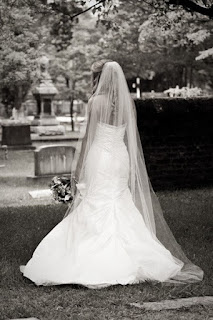Birdcage veils are very short, usually attached to a comb, and comes forward to cover half or all of the face. They are generally made of wide french netting or tulle and can associated with a more vintage or retro look.
Blusher
A short veil that covers the bride's face as she enters the ceremony. Blusher veils are very traditional.
Shoulder
Touches or just covers the shoulders.
Elbow
Ends at the elbows or waist. This veil can be poofy, and looks great with fuller skirts.
Fingertip
Fingertip veils cup right under the hips, just past the fingertips. These veils are one of the most popular and versatile lengths, and can go with just about every style of gown.
Waltz
Waltz length veils fall in between knee and floor length.
Chapel length veils measure twelve to eighteen inches past a chapel train.
The grandest of veils, cathedral length veils measure twelve to eighteen inches past a cathedral train, usually about three to three and a half yards.
Most veils are made of tulle, but they can be made with other fabrics as well. You can also choose a raw edge veil, which was no edging or hem, or you can find a veil that is trimmed with fabric, beading, lace, or embroidery. As a general rule, the veil should coordinate with and compliment the style of your wedding gown.


















No comments:
Post a Comment